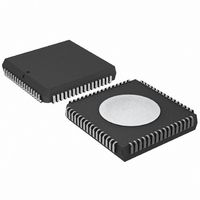P87C554SBAA,512 NXP Semiconductors, P87C554SBAA,512 Datasheet - Page 30

P87C554SBAA,512
Manufacturer Part Number
P87C554SBAA,512
Description
IC 80C51 MCU 16K OTP 64-PLCC
Manufacturer
NXP Semiconductors
Series
87Cr
Specifications of P87C554SBAA,512
Core Processor
8051
Core Size
8-Bit
Speed
16MHz
Connectivity
EBI/EMI, I²C, UART/USART
Peripherals
POR, PWM, WDT
Number Of I /o
40
Program Memory Size
16KB (16K x 8)
Program Memory Type
OTP
Ram Size
512 x 8
Voltage - Supply (vcc/vdd)
2.7 V ~ 5.5 V
Data Converters
A/D 8x10b
Oscillator Type
Internal
Operating Temperature
0°C ~ 70°C
Package / Case
68-PLCC
Cpu Family
87C
Device Core
80C51
Device Core Size
8b
Frequency (max)
16MHz
Interface Type
I2C/UART
Total Internal Ram Size
512Byte
# I/os (max)
40
Number Of Timers - General Purpose
3
Operating Supply Voltage (typ)
5V
Operating Supply Voltage (max)
5.5V
Operating Supply Voltage (min)
4.5V
On-chip Adc
7-chx10-bit
Instruction Set Architecture
CISC
Operating Temp Range
0C to 70C
Operating Temperature Classification
Commercial
Mounting
Surface Mount
Pin Count
68
Package Type
PLCC
Processor Series
P87C5x
Core
80C51
Data Bus Width
8 bit
Data Ram Size
512 B
Maximum Clock Frequency
16 MHz
Number Of Programmable I/os
40
Number Of Timers
3
Operating Supply Voltage
2.7 V to 5.5 V
Maximum Operating Temperature
+ 70 C
Mounting Style
SMD/SMT
3rd Party Development Tools
PK51, CA51, A51, ULINK2
Minimum Operating Temperature
0 C
Lead Free Status / RoHS Status
Lead free / RoHS Compliant
Eeprom Size
-
Lead Free Status / Rohs Status
Compliant
Other names
568-1254-5
935263385512
P87C554SBAA
935263385512
P87C554SBAA
Available stocks
Company
Part Number
Manufacturer
Quantity
Price
Company:
Part Number:
P87C554SBAA,512
Manufacturer:
NXP Semiconductors
Quantity:
10 000
Philips Semiconductors
Interrupts
The P87C554 has fifteen interrupt sources, each of which can be
assigned one of four priority levels. The five interrupt sources
common to the 80C51 are the external interrupts (INT0 and INT1),
the timer 0 and timer 1 interrupts (IT0 and IT1), and the serial I/O
interrupt (RI or TI). In the P87C554, the standard serial interrupt is
called SIO0.
The eight Timer T2 interrupts are generated by flags CTI0-CT13,
CMI0-CMI2, and by the logical OR of flags T2OV and T2BO. Flags
CTI0 to CT13 are set by input signals CT0I to CT3i. Flags CMI0 to
CMI2 are set when a match occurs between Timer T2 and the
compare registers CM0, CM1, and CM2. When an 8-bit or 16-bit
overflow occurs, flags T2BO and T2OV are set, respectively. These
nine flags are not cleared by hardware and must be reset by
software to avoid recurring interrupts.
The ADC interrupt is generated by the ADCI flag in the ADC control
register (ADCON). This flag is set when an ADC conversion result is
ready to be read. ADCI is not cleared by hardware and must be
reset by software to avoid recurring interrupts.
The SIO1 (I
control register (S1CON). This flag is set when S1STA is loaded
with a valid status code.
The ADCI flag may be reset by software. It cannot be set by
software. All other flags that generate interrupts may be set or
cleared by software, and the effect is the same as setting or
resetting the flags by hardware. Thus, interrupts may be generated
by software and pending interrupts can be canceled by software.
Interrupt Enable Registers: Each interrupt source can be
individually enabled or disabled by setting or clearing a bit in the
2002 Mar 25
80C51 8-bit microcontroller – 12 clock operation
16K/512 OTP/RAM, 8 channel 10-bit A/D, I
capture/compare, high I/O
2
C) interrupt is generated by the SI flag in the SIO1
IEN0 (A8H)
BIT
IEN0.7
IEN0.6
IEN0.5
IEN0.4
IEN0.3
IEN0.2
IEN0.1
IEN0.0
(MSB)
EA
7
EAD
SYMBOL
EA
EAD
ES1
ES0
ET1
EX1
ET0
EX0
6
Figure 27. Interrupt Enable Register (IEN0)
ES1
5
FUNCTION
Global enable/disable control
Eanble ADC interrupt
Enable SIO1 (I
Enable SIO0 (UART) interrupt
Enable Timer 1 interrupt
Enable External interrupt 1
Enable Timer 0 interrupt
Enable External interrupt 0
0 = No interrupt is enabled
1 = Any individually enabled interrupt will be accepted
2
C, PWM,
ES0
4
28
2
C) interrupt
ET1
They are the IENx, IPx, and IPxH. (See Figures 29, 30, and 31.) The
as on the 80C51. An interrupt will be serviced as long as an interrupt
3
interrupt enable special function registers IEN0 and IEN1. All
interrupt sources can also be globally enabled or disabled by setting
or clearing bit EA in IEN0. The interrupt enable registers are
described in Figures 27 and 28.
There are 3 SFRs associated with each of the four-level interrupts.
IPxH (Interrupt Priority High) register makes the four-level interrupt
structure possible.
The function of the IPxH SFR is simple and when combined with the
IPx SFR determines the priority of each interrupt. The priority of
each interrupt is determined as shown in the following table:
The priority scheme for servicing the interrupts is the same as that
for the 80C51, except there are four interrupt levels rather than two
of equal or higher priority is not already being serviced. If an
interrupt of equal or higher level priority is being serviced, the new
interrupt will wait until it is finished before being serviced. If a lower
priority level interrupt is being serviced, it will be stopped and the
new interrupt serviced. When the new interrupt is finished, the lower
priority level interrupt that was stopped will be completed.
IPxH.x
PRIORITY BITS
0
0
1
1
EX1
2
ET0
IPx.x
1
0
1
0
1
(LSB)
EX0
0
Level 0 (lowest priority)
Level 1
Level 2
Level 3 (highest priority)
INTERRUPT PRIORITY LEVEL
INTERRUPT PRIORITY LEVEL
SU00762
P87C554
Product data
















